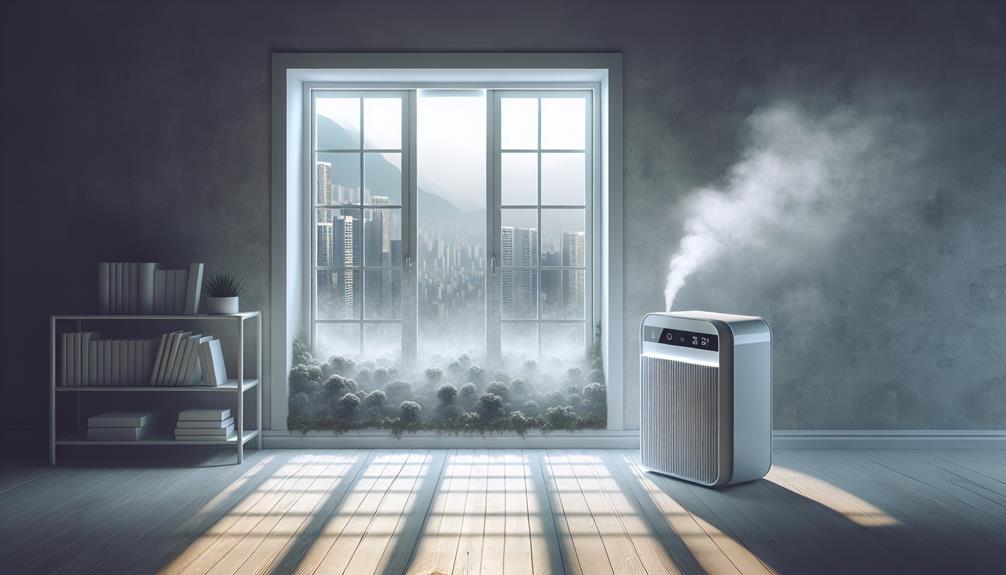Ensuring the effectiveness of your air purifier is crucial for maintaining a healthy indoor environment. But how can you truly know if your device is doing its job?
Various methods can provide insight into its functionality, from simple visual checks to more technical assessments. Understanding the signs that indicate your air purifier is working optimally can give you peace of mind and confidence in the air quality of your surroundings.
So, how can you be sure your air purifier is truly making a difference?
Key Takeaways
- Regularly inspect and maintain the air purifier filter to ensure proper functioning.
- Monitor air quality using monitors to track pollutant levels and assess the purifier's impact.
- Assess allergen reduction by measuring dust and pollen levels for improved indoor air quality.
- Test the purifier's odor elimination capability by introducing strong scents and evaluating air quality.
Air Purifier Filter Inspection
When determining the functionality of your air purifier, a crucial step is conducting a thorough inspection of the air purifier filter. Filter maintenance plays a key role in ensuring that your air purifier is operating at its optimal level. Regularly check the filter for any signs of dust, dirt, or blockages that may impede airflow and reduce the purifier's efficiency. If the filter appears dirty or clogged, follow the manufacturer's instructions for proper cleaning or replacement.
Troubleshooting tips for filter maintenance include checking the user manual for specific guidelines on how often the filter should be cleaned or replaced. Some air purifiers come with filter replacement indicators that signal when it's time for a new filter. Additionally, make sure the filter is properly installed and securely in place to prevent air leakage around the filter.
Monitor Air Quality Changes
To effectively assess the performance of your air purifier, diligent monitoring of air quality changes is essential. Indoor air quality analysis plays a vital role in this process. Utilizing devices such as air quality monitors can help track pollutant levels in your home. These monitors measure various pollutants like particulate matter, volatile organic compounds (VOCs), carbon dioxide, and more, providing real-time data on the air you breathe. By regularly checking these measurements, you can observe fluctuations in pollutant levels and determine if your air purifier is effectively reducing them.
Monitoring air quality changes allows you to see the impact of your air purifier over time. If pollutant levels remain consistently high despite the purifier running, it may indicate issues with the device or the need for additional purification methods. Conversely, noticeable improvements in air quality demonstrate the efficacy of your air purifier in creating a healthier indoor environment. By consistently tracking pollutant levels, you can make informed decisions regarding the maintenance and efficiency of your air purifier.
Check for Reduced Allergens
Continuously monitoring air quality changes can also involve checking for reduced allergens in your indoor environment as an indicator of your air purifier's effectiveness. One way to assess this is by measuring dust reduction and pollen levels in the air. A functioning air purifier should lead to a noticeable decrease in these allergens, contributing to a cleaner and healthier indoor atmosphere.
Apart from visible particulate matter, the impact of reduced allergens can also be felt through respiratory improvements. A successful air purifier will help in lowering allergen levels, which can result in fewer respiratory issues for individuals sensitive to dust and pollen. This may translate to experiencing less sneezing, coughing, or difficulty breathing indoors. Monitoring these changes over time can provide valuable insights into the effectiveness of your air purifier and its ability to create a more allergy-friendly environment for occupants.
Odor Elimination Test
An effective method to evaluate the performance of your air purifier is through conducting an odor elimination test in your indoor space. To perform this test, introduce a strong but safe odor, such as from cooking or tobacco smoke, into the room. Allow the air purifier to run for a sufficient amount of time, typically around 30 minutes to an hour, depending on the purifier's capacity and room size. After this time, assess the air quality by conducting a scent detection test. If the purifier is working effectively, the previously introduced odor should be significantly reduced or completely eliminated.
To further evaluate the air purifier's performance, consider conducting airflow analysis. Check if the purifier is circulating air adequately throughout the room by placing airflow indicators in various locations and observing their movement. Proper airflow ensures that the purifier can capture odors efficiently. By combining odor detection with airflow analysis, you can comprehensively assess your air purifier's ability to eliminate unwanted smells and maintain a fresh indoor environment.
Listen for Fan Operation
When evaluating the functionality of your air purifier, a crucial aspect to consider is listening for the operation of the fan. The fan in an air purifier is responsible for drawing air into the unit, where it passes through the filters to remove impurities. By listening for the fan, you can ensure that air is being circulated and filtered effectively.
One key factor to pay attention to is the noise level of the fan. While some noise is expected due to the air movement, excessively loud or unusual sounds could indicate a problem with the fan mechanism. If the fan is too noisy, it may disrupt your living environment and could be a sign of impending mechanical issues.
Additionally, monitoring the power consumption of the air purifier while the fan is running can provide insights into its efficiency. Higher power consumption could suggest that the fan is working harder, possibly due to clogged filters or other obstructions that hinder airflow. Optimal fan operation should maintain a balance between effective air purification and reasonable power usage.
Frequently Asked Questions
How Often Should I Replace the Filter in My Air Purifier?
The filter lifespan of an air purifier depends on various factors such as usage frequency and air quality. Generally, filters should be replaced every 6 to 12 months to maintain optimal performance.
It is recommended to check the manufacturer's guidelines for specific maintenance schedules. Regularly changing the filter ensures that the air purifier continues to effectively remove pollutants from the air, promoting a healthier indoor environment.
Can an Air Purifier Help With Pet Dander Allergies?
Air purifiers can be effective in reducing pet dander, a common allergen for many individuals. By capturing pet hair and dander particles in their filters, air purifiers can help improve indoor air quality and provide allergy relief to those sensitive to pet allergens.
The HEPA filters in air purifiers are especially efficient at trapping these microscopic particles, making them a valuable tool in managing pet dander allergies within the home.
Are There Any Health Risks Associated With Using an Air Purifier?
Indoor pollutants pose potential risks when using an air purifier. While these devices can effectively reduce airborne contaminants, improper maintenance may lead to respiratory concerns. Regular filter replacement and appropriate sizing of the purifier are crucial to prevent health issues.
Understanding the specific pollutants in your environment and selecting a purifier designed to address them can mitigate any associated health risks. Proper use and maintenance are essential for optimal air quality and health benefits.
Can an Air Purifier Remove Dust Mites From the Air?
An air purifier equipped with a HEPA filter can effectively capture and remove dust mites from the air, aiding in dust mite control. This can significantly reduce allergens in the environment, providing relief to individuals suffering from allergies triggered by dust mites.
Will an Air Purifier Help With Reducing Pollen Indoors?
In addressing pollen control and allergy relief indoors, an air purifier can be instrumental. By filtering out pollen particles from the indoor environment, air purifiers contribute significantly to improving home comfort and reducing allergy symptoms.
Utilizing HEPA filters can be particularly effective in capturing pollen, ensuring cleaner air quality. Regular maintenance and filter replacements are essential to ensure optimal performance of the air purifier in combating pollen and enhancing indoor air quality.
Conclusion
In conclusion, monitoring the functionality of an air purifier involves several key steps:
- Inspecting the filter
- Monitoring air quality changes
- Checking for reduced allergens
- Conducting an odor elimination test
- Listening for fan operation
Like a vigilant gatekeeper, a properly functioning air purifier ensures that the air you breathe is clean and free of contaminants, providing you with a healthier living environment.

